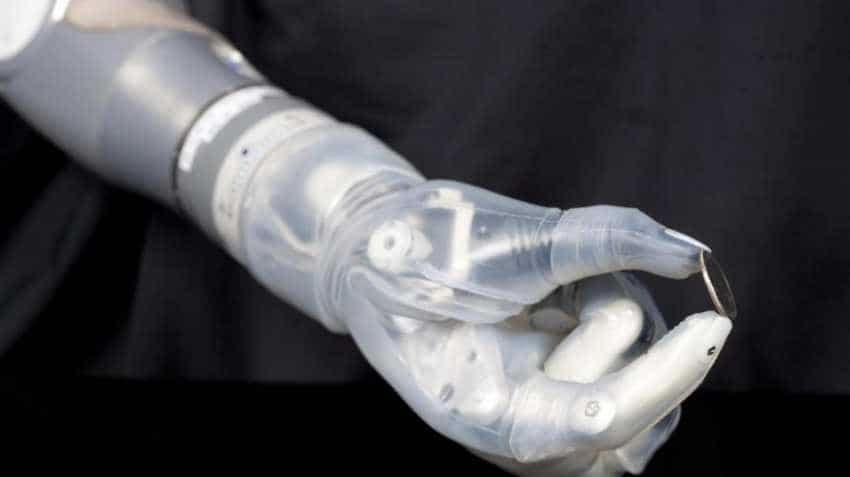Electronic glove to give robots sense of touch
Stanford scientists have developed an electronic glove containing sensors that could one day give robotic hands the human-like sense of touch and dexterity.

Stanford scientists have developed an electronic glove containing sensors that could one day give robotic hands the human-like sense of touch and dexterity. In a study published in the journal Science Robotics, researchers showed that the sensors work well enough to allow a robotic hand to touch a delicate berry and handle a pingpong ball without squashing them.
"This technology puts us on a path to one day giving robots the sort of sensing capabilities found in human skin," said Zhenan Bao, from Stanford University in the US. The sensors in the glove's fingertips simultaneously measure the intensity and direction of pressure, two qualities essential to achieving manual dexterity, researchers said.
They must still perfect the technology to automatically control these sensors but when they do, a robot wearing the glove could have the dexterity to hold an egg between thumb and forefinger without smashing it or letting it slip.
The electronic glove imitates the way layers of human skin work together to give our hands their extraordinary sensitivity. Our outer layer of skin is imbued with sensors to detect pressure, heat and other stimuli, researchers said. Our fingers and palms are particularly rich in touch sensors.
Postdoctoral scholar Clementine Boutry and master's student Marc Negre led development of the electronic sensors that mimic this human mechanism. Each sensor on the fingertip of the robotic glove is made of three flexible layers that work in concert.
The top and bottom layers are electrically active. The researchers laid a grid of electrical lines on each of the two facing surfaces, like rows in a field, and turned these rows perpendicular to each other to create a dense array of small sensing pixels.
They also made the bottom layer bumpy like the spinosum. To test their technology the researchers placed their three-layered sensors on the fingers of a rubber glove, and put the glove on a robotic hand.
Eventually the goal is to embed sensors directly into a skin-like covering for robotic hands.
In one experiment, they programmed the glove-wearing robotic hand to gently touch a berry without damaging it. They also programmed the gloved hand to lift and move a pingpong ball without crushing it, by using the sensor to detect the appropriate shear force to grasp the ball without dropping it.
With proper programming a robotic hand wearing the current touch-sensing glove could perform a repetitive task such as lifting eggs off a conveyor belt and placing them into cartons. The technology could also have applications in robot-assisted surgery, where precise touch control is essential.
However, the ultimate goal is to develop an advanced version of the glove that automatically applies just the right amount of force to handle an object safely without prior programming.
Watch This Zee Business Vidoe Here:
"We can programme a robotic hand to touch a raspberry without crushing it, but we're a long way from being able to touch and detect that it is raspberry and enable the robot to pick it up," Bao said.
Get Latest Business News, Stock Market Updates and Videos; Check your tax outgo through Income Tax Calculator and save money through our Personal Finance coverage. Check Business Breaking News Live on Zee Business Twitter and Facebook. Subscribe on YouTube.
RECOMMENDED STORIES

Small SIP, Big Impact: Rs 1,111 monthly SIP for 40 years, Rs 11,111 for 20 years or Rs 22,222 for 10 years, which do you think works best?

Rs 3,500 Monthly SIP for 35 years vs Rs 35,000 Monthly SIP for 16 Years: Which can give you higher corpus in long term? See calculations

SBI 444-day FD vs PNB 400-day FD: Here's what general and senior citizens will get in maturity on Rs 3.5 lakh and 7 lakh investments in special FDs?
12:58 PM IST









 TCS partners with IIT Kharagpur to launch advanced research centre
TCS partners with IIT Kharagpur to launch advanced research centre DiFACTO raises Rs 40 crore funding from Stakeboat Capital in Series A round
DiFACTO raises Rs 40 crore funding from Stakeboat Capital in Series A round Assistive dogs to medical cobots: Robots set to redefine efficiency, safety, adaptability across industries
Assistive dogs to medical cobots: Robots set to redefine efficiency, safety, adaptability across industries Telangana becomes first state to launch robotics policy framework
Telangana becomes first state to launch robotics policy framework World looking towards India for affordable, sustainable tech-enabled solutions: PM Narendra Modi
World looking towards India for affordable, sustainable tech-enabled solutions: PM Narendra Modi